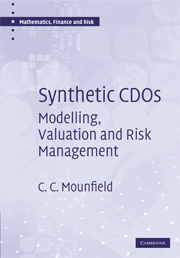Book contents
- Frontmatter
- Contents
- Preface
- Acknowledgements
- 1 A primer on collateralised debt obligations
- 2 Modelling of obligor default
- 3 Valuation of credit default swaps
- 4 Credit indices
- 5 Valuation of default baskets
- 6 Valuation of synthetic CDOs
- 7 Phenomenology of the standard market model
- 8 Risk quantification of synthetic CDOs
- 9 Implied and base correlations
- 10 Extensions of the standard market model
- 11 Exotic CDOs
- 12 Correlation trading of synthetic CDO tranches
- 13 Risk management of a portfolio of synthetic CDOs
- 14 Hedging simulation of structured credit products
- Appendix A Explanation of common notation
- Appendix B Simulated annealing
- References
- Index
3 - Valuation of credit default swaps
Published online by Cambridge University Press: 06 July 2010
- Frontmatter
- Contents
- Preface
- Acknowledgements
- 1 A primer on collateralised debt obligations
- 2 Modelling of obligor default
- 3 Valuation of credit default swaps
- 4 Credit indices
- 5 Valuation of default baskets
- 6 Valuation of synthetic CDOs
- 7 Phenomenology of the standard market model
- 8 Risk quantification of synthetic CDOs
- 9 Implied and base correlations
- 10 Extensions of the standard market model
- 11 Exotic CDOs
- 12 Correlation trading of synthetic CDO tranches
- 13 Risk management of a portfolio of synthetic CDOs
- 14 Hedging simulation of structured credit products
- Appendix A Explanation of common notation
- Appendix B Simulated annealing
- References
- Index
Summary
Introduction
In this chapter we introduce and analyse the most common and vanilla of credit derivative instruments, namely credit default swaps (or CDSs). In general terms a credit default swap is a bilateral contract agreed over-the-counter (as opposed to exchange traded) by two counterparties whereby one counterparty agrees to provide protection to the other counterparty against a specified default event of a third reference counterparty (distinct from the other two). CDSs therefore allow the credit risk component of an exposure to be isolated and traded. The purchaser of credit protection trades away the credit risk but retains the market risk (in the form of mark-to-market (MtM) fluctuations). Because the protection is with respect to a single reference counterparty the generic term ‘single-name’ is often used to refer to CDSs (and other related credit derivatives which reference a single counterparty). This will provide a simple way of summarising the key difference between CDSs and portfolio products such as CDOs (which will be referred to as ‘portfolio’ products!).
CDS cashflow mechanics are introduced in Section 3.2 and the current market standard model for their valuation (based upon the hazard rate approach introduced in Chapter 2) in Section 3.3. The market standard method for the calibration of the model to market observed prices based on a bootstrapping procedure is also discussed in Section 3.4. Section 3.5 then considers risk sensitivities of the product and introduces simple measures to quantify these risks.
- Type
- Chapter
- Information
- Synthetic CDOsModelling, Valuation and Risk Management, pp. 45 - 65Publisher: Cambridge University PressPrint publication year: 2008



